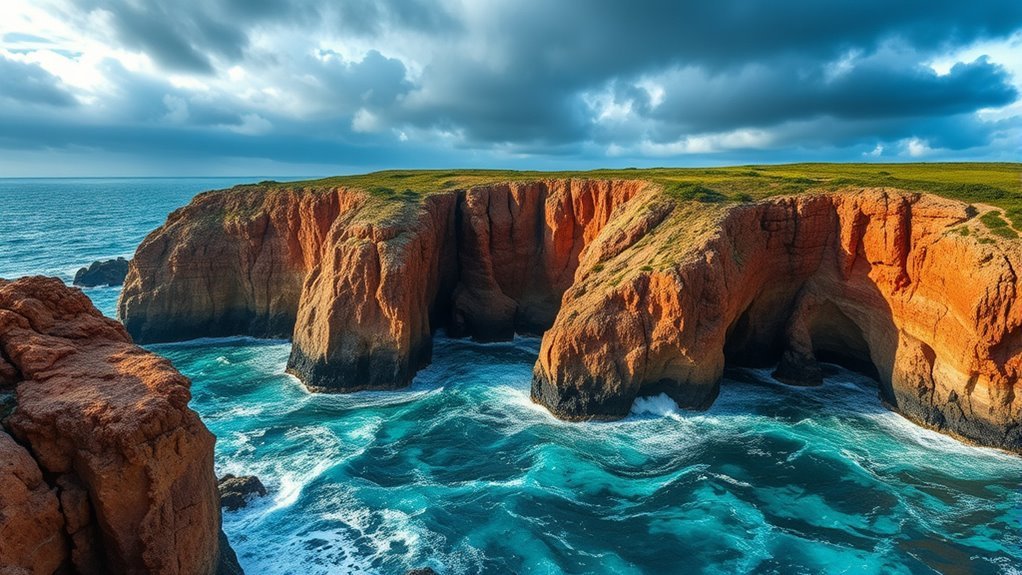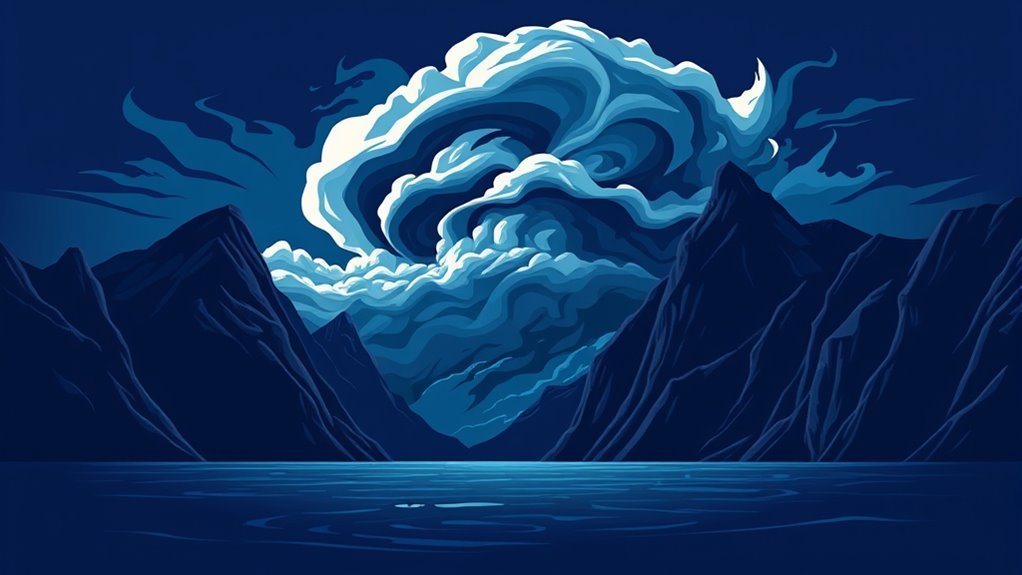The most squall-prone areas include the Great Lakes, Gulf Coast, and Northeast U.S. These regions experience frequent storms due to the convergence of diverse air masses and unique geographical features. For instance, the Great Lakes see cold Canadian air collide with warm, moist Gulf air. In the Gulf Coast, warm waters intensify storms, while the Northeast faces rapid weather shifts. Understanding these dynamics highlights the interplay of temperature, humidity, and topography in storm formation. More engaging revelations await.
Main Points
- Geographical Convergence: Areas where warm, moist air meets cold, dry air, such as the Great Lakes and Northeast U.S., frequently experience squalls due to instability.
- Topographical Influence: Mountain ranges, like those in the Pacific Northwest, enhance squall formation through orographic lift and localized weather effects.
- Seasonal Variability: Seasonal shifts, especially in coastal regions, can lead to increased atmospheric instability, promoting the development of intense squalls.
- Warm Water Interaction: Coastal areas, such as the Gulf Coast and Caribbean, see intensified storms from warm waters meeting cooler air masses, driving storm activity.
- Humidity Levels: High humidity in regions like the Mediterranean Coast can amplify storm intensity, leading to frequent squall occurrences during specific seasons.
The Great Lakes Region: A Battleground of Air Masses
The Great Lakes region serves as a dynamic intersection for diverse air masses, creating a unique meteorological environment. Cold, dry air from Canada frequently collides with warm, moist air from the Gulf of Mexico, leading to the formation of intense weather systems.
This juxtaposition cultivates an ideal setting for squalls, defined by rapid changes in wind speed and direction. The lakes themselves contribute to localized weather phenomena, as their expansive bodies of water can modify temperatures and humidity levels.
As the seasons change, the region experiences a variety of storm types, including snow squalls in winter and severe thunderstorms in summer. The interaction of these air masses often results in sudden and severe weather conditions, making the Great Lakes a focal point for meteorologists studying storm patterns.
Consequently, this battleground of air masses highlights the complexity and unpredictability of weather in the area.
The Gulf Coast: Warm Waters and Unpredictable Weather

How does the warm waters of the Gulf Coast influence its weather patterns?
The Gulf Coast's warm waters play a crucial role in shaping its climate, contributing to frequent and unpredictable weather events. When warm, moist air from the Gulf interacts with cooler air masses from the north, it often leads to the development of thunderstorms and squalls. This unique atmospheric interplay can create sudden changes in weather, resulting in intense rainfall and strong winds.
Additionally, the Gulf Coast is particularly vulnerable to tropical storms and hurricanes, which form over the warm waters during the hurricane season.
The combination of raised sea surface temperatures and the region's geography allows these storms to intensify rapidly, posing considerable threats to coastal communities.
Consequently, the Gulf Coast's warm waters serve as both a catalyst for severe storms and a determinant of its often volatile weather patterns.
The Pacific Northwest: Mountains and Marine Influences
The Pacific Northwest is defined by its unique geographic features, including mountainous terrain and proximity to the ocean, which greatly influence local weather patterns.
The interaction between marine air and topography often leads to intense storms and seasonal squalls. Understanding these dynamics is essential for comprehending the region's variable climate.
Geographic Features Impacting Weather
Mountains and marine influences play an essential role in shaping the weather patterns of the Pacific Northwest. The region's rugged mountain ranges, particularly the Cascades, act as formidable barriers to prevailing winds.
This topography leads to orographic lift, where moist air is forced upward, cooling and condensing into precipitation. As a result, the western slopes receive abundant rainfall, while the eastern slopes remain relatively dry, creating a rain shadow effect.
Additionally, the proximity to the Pacific Ocean contributes to the moderation of temperatures and increased humidity levels. These geographic features interact dynamically, resulting in frequent and intense storm systems that characterize the region's climate.
Understanding these influences is vital for predicting the area's distinct weather phenomena.
Marine Influence on Storms
What factors contribute to the intensity and frequency of storms in the Pacific Northwest? The region's unique geography and marine influences play a vital role.
The Pacific Ocean serves as a key moisture source, where warm, moist air is drawn inland. As this air encounters the coastal mountain ranges, it is forced upward, leading to orographic lift, which boosts precipitation.
The collision of varying air masses, particularly warm, moist Pacific air with cooler continental air, creates instability conducive to storm development. Additionally, the presence of the jet stream often improves the formation of low-pressure systems, further increasing storm activity.
These combined elements result in a dynamic weather pattern, making the Pacific Northwest particularly susceptible to frequent and intense storm events.
Seasonal Variability in Squalls
Although squalls can occur at any time of year in the Pacific Northwest, their intensity and frequency exhibit notable seasonal variability influenced by the region's unique topography and marine conditions.
During the winter months, the combination of moist air from the Pacific Ocean and mountainous terrain leads to stronger squalls, often accompanied by heavy precipitation and gusty winds.
Conversely, summer months typically see a decrease in squall activity, as warmer, drier air dominates the atmosphere.
Nevertheless, occasional late summer squalls may arise due to ocean temperature fluctuations and shifting winds.
This seasonal pattern highlights the complex interplay between regional geography and climatic factors, which together create a dynamic environment for squall formation throughout the year.
The Mediterranean Coast: Convergence of Weather Systems

The Mediterranean coast serves as a dynamic meeting point for diverse weather systems, influenced by its unique geographic and climatic characteristics. This region experiences the convergence of warm, moist air from the Mediterranean Sea and cooler, drier air from surrounding landmasses. Such interactions often lead to notable atmospheric instability, promoting the development of squalls.
The presence of the mountain ranges to the north and the south amplifies this phenomenon, as they can force air to rise rapidly, cooling it and resulting in precipitation.
Additionally, seasonal shifts, particularly during autumn and spring, heighten the likelihood of intense weather events. The Mediterranean's varying topography further complicates weather patterns, allowing for localized squall formations.
As a result, coastal regions are frequently subject to sudden storms, which contribute to the area's reputation as a squall-prone environment, impacting both local ecosystems and human activities.
The Rocky Mountains: Elevation and Temperature Variations

The Rocky Mountains present a unique interplay of elevation and temperature that greatly influences local weather patterns.
As altitude increases, temperature variations become more pronounced, leading to frequent and intense storms. This dynamic creates conditions conducive to squalls, making the region particularly susceptible to abrupt weather changes.
Elevation Impact on Weather
As elevation increases, considerable variations in temperature and weather patterns become evident, particularly in regions like the Rocky Mountains. The topography greatly influences local climates, creating distinct microclimates.
Higher elevations typically experience cooler temperatures, which can lead to a range of weather phenomena, including increased precipitation and cloud formation. Additionally, the orographic lift effect causes air to rise and cool as it encounters the mountains, resulting in improved moisture retention and potential storm development.
These factors contribute to a dynamic weather environment marked by rapid changes. The impact of elevation on weather also dictates the types of ecosystems found in these areas, further emphasizing the complex relationship between altitude and climatic conditions in mountainous regions.
Temperature Fluctuations and Storms
Although temperature fluctuations are common in many regions, they are particularly pronounced in the Rocky Mountains due to the varying elevations and complex terrain. This region experiences rapid changes in temperature, often leading to sudden storms.
The interplay between warm and cold air masses can trigger squalls, contributing to the area's storm-prone nature. Key factors influencing these fluctuations include:
- Elevation: Higher altitudes experience cooler temperatures.
- Topography: Mountain ranges disrupt air flow, creating localized weather patterns.
- Seasonal Variations: Different seasons bring distinct temperature changes.
- Humidity Levels: Variations in moisture can intensify storm development.
These elements collectively explain why the Rocky Mountains are notorious for their unpredictable weather and frequent squalls.
The Northeast U.S.: Rapid Weather Changes and Nor'easters
In the Northeast U.S., swift weather changes are a hallmark of the region, often leading to the development of powerful nor'easters. These intense storms typically form when cold Arctic air collides with warm, moist air from the Atlantic Ocean. This collision generates considerable atmospheric instability, resulting in rapid shifts in temperature and precipitation.
The geography of the Northeast, with its varied terrain and proximity to large bodies of water, further exacerbates these conditions. As nor'easters approach, they can bring heavy snowfall, strong winds, and coastal flooding, impacting both urban and rural areas. The winter months are particularly prone to these storms, which can develop with little warning.
Residents must remain vigilant, as forecasts can change rapidly, making preparedness essential. Understanding the mechanics behind these storms allows for better anticipation and response, ultimately mitigating the impact of these frequent and severe weather events on communities.
The Caribbean: Tropical Storms and Squall Lines
The Caribbean experiences a unique climate shaped by its geographical location, making it particularly vulnerable to tropical storms and squall lines. The warm waters of the Atlantic Ocean fuel these storms, leading to frequent and intense weather patterns.
Tropical storms often develop into hurricanes, while squall lines can result in sudden and heavy rainfall, strong winds, and turbulent conditions.
Factors contributing to the prevalence of these phenomena include:
- Warm Ocean Temperatures: These provide the necessary energy for storm development.
- Trade Winds: They can steer storms towards the Caribbean, increasing the likelihood of impacts.
- Geographical Features: The region's islands can improve local weather patterns.
- Seasonal Variability: The Atlantic hurricane season (June to November) sees heightened storm activity.
Understanding these elements helps explain why the Caribbean remains one of the most storm-prone areas in the world.
Common Questions
How Do Squalls Differ From Regular Storms?
Squalls are defined by sudden, intense bursts of wind and rain, differing from regular storms that typically develop slowly and maintain longer durations. Their rapid onset and brief intensity distinguish them from more prolonged weather events.
What Safety Measures Should Be Taken During a Squall?
During a squall, individuals should seek shelter indoors, avoid windows, secure outdoor objects, and refrain from driving. Staying informed through weather updates is vital to guarantee personal safety and preparedness for sudden changes in conditions.
Can Squalls Occur in Winter?
Squalls can indeed occur in winter, often defined by sudden, intense bursts of wind and snow. These winter squalls may lead to reduced visibility and hazardous conditions, prompting caution among those traveling or engaging in outdoor activities.
How Do Climate Change Effects Influence Squall Frequency?
The effects of climate change may increase squall frequency by altering atmospheric conditions, such as temperature and humidity. These changes can lead to more unstable air masses, resulting in intensified and more frequent squall events.
Are Squalls More Common at Certain Times of the Year?
Squalls tend to be more common during changing seasons, particularly spring and fall. During these times, atmospheric conditions often shift rapidly, creating instability that can lead to the development of intense, short-lived storm systems.

